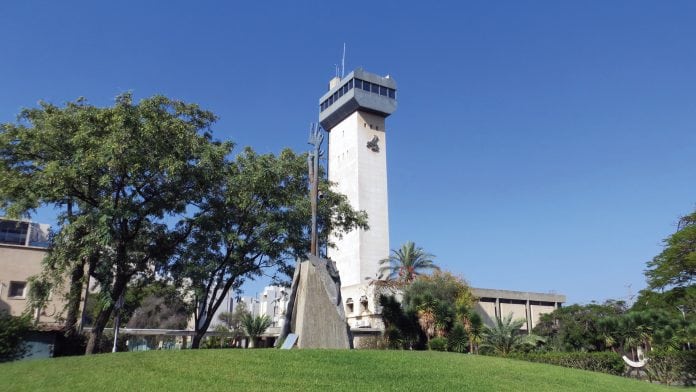
Professor Shulamit Michaeli presents Bar-Ilan University, a Tel Aviv-based university boasting big ambitions, unparalleled achievements, and ever-increasing academic prowess.
Bar-Ilan University (BIU), located in the outskirts of Tel Aviv, has big aspirations: it intends to increase the number of researchers in the STEM (science, technology, engineering and maths) fields from 240 to 340 by 2028. The university’s unique multidisciplinary, collaborative approach is the secret to its unrivalled achievements in numerous fields of scientific research.
Here, Professor Shulamit Michaeli – vice-president for research at BIU, an accomplished microbiologist, past dean of the Mina and Everard Goodman Faculty of Life Sciences, and founding director of BIU’s Nano-Medicine Center – shares her thoughts on the exciting winds blowing at BIU. Spearheading the new Dangoor Personalized-Medicine Research Center, Michaeli offers a peek into BIU’s cutting-edge research projects designed to make a significant impact on our lives.
What makes Bar-Ilan University unique?
A fascinating phenomenon is occurring on BIU’s campus, located in the City of Ramat Gan in the Tel Aviv District of Israel. Since its founding as one of the first public research universities in Israel, BIU’s achievements in the sciences and humanities have left a remarkable imprint on the landscape of the young country.
BIU was founded in 1955 as a religious Jewish university, the only university in the world with a dedicated Faculty of Jewish Studies. Bar Ilan’s unique attribute lies in the combination of our devotion to Jewish values, community involvement, and a practical, interdisciplinary approach.
Following the mass immigration from Russia to Israel in the early 1990s, BIU opened its gates to the many outstanding immigrant Russian scientists in maths and physics.
Professor Moshe Kaveh, an internationally acclaimed physicist, and BIU’s president at that time, led the university as it emerged as a comprehensive university, with faculties in all fields, including law, STEM, social sciences and the humanities. He put a particular emphasis on the STEM areas. Subsequently, he initiated the establishment of the Brain Research Center, the Nano Center, the School of Engineering, and, in 2011, the Medical School in Safed.
The university fosters a culture of dialogue among scholars from its various disciplines. The idea is to encourage discourse, rather than focusing solely on individual research. This is based on the underlying conception that collaboration is essential to attain meaningful and impactful research breakthroughs.
Bar-Ilan University has evolved over the years as a vibrant centre that addresses the most fundamental questions about contemporary Judaism, while also cultivating a unique atmosphere of open exchange of ideas. Tolerance, civility, and religious diversity are leitmotifs at BIU. This is reflected in the student body, which represents a mosaic of Israeli society, including secular, religious, and ultra-Orthodox Jews, as well as Arabs, Christians and other ethnic groups. Immigrant students from different countries contribute greatly to the cultural diversity on campus, leading to creative problem solving.
In the coming years, we plan to transform BIU into the most relevant, diverse and exciting academic centre. To paraphrase the inspirational quote of Johann Wolfgang von Goethe in the 19th Century, BIU provides its students with ‘wings’ and ‘roots’: ‘wings’ to ‘fly’ academically and scientifically, to push back new boundaries of knowledge, and to explore new intellectual universes, and ‘roots’ to ‘bind’ them to this Earth, so they fulfill their moral and ethical obligations and become better individuals.
The university’s commitment to the community is evident through several outreach programmes that encourage student involvement in the local community. One such example is the Bear Hospital programme, which is intended to reduce the anxiety of preschoolers and young children who require medical care − an inspiring initiative by BIU medical students together with the medical faculty. Other examples of service to the community are subsidised psychotherapy sessions offered by the university to post-traumatic stress disorder (PTSD) patients and subsidised eye exams for underprivileged populations.
What are the university’s current plans for expanding research in STEM disciplines?
In the next decade the university plans to recruit 100 STEM scientists in the fields of medicine, life sciences, exact sciences, engineering and physics, which will increase the number of STEM researchers to 340. This follows the announcement of Israel’s PBC (Planning and Budgeting Committee of the Council for Higher Education) that it will provide generous grant funding and budgeting for infrastructure in such areas as quantum physics and computing, data science and personalised medicine.
The Shanghai Academic Ranking has ranked BIU in the top 100 universities in the social sciences. Interestingly, although our ranking in STEM fields is only among the top 400-500 universities, it is still a relatively high ranking considering the small number of BIU’s STEM researchers. One can only imagine how high this ranking will reach after we recruit 100 more STEM researchers.
In addition to the planned increase in STEM researchers, the university aims to increase the number of international students and postdoctoral students in these areas. This initiative is generously funded by the Zuckerman STEM Leadership Program. In order to accommodate local and international students, two contemporary high-rise student-dorm buildings are currently under construction. The plan is to expand bed capacity from the 600 available today to over 2,000 beds within three years.
What are some highlights of the breakthrough research conducted at Bar-Ilan University in the STEM areas?
Bar-Ilan University has eight faculties and 17,828 students, 4,684 of whom are STEM students, which constitutes 26% of the student body. This includes undergraduates, graduates, PhD and postdoc students, in the four STEM faculties of medicine, exact Sciences (mathematics, physics, chemistry, computer science), life sciences and engineering.
Of the total 1,350 BIU faculty members, including 671 principal investigators (PIs), 240 PIs are in the fields of STEM. All STEM PIs are active partners in national and international science and technology initiatives.
Over the past decade several university patents in such fields as biomedicine, nanomedicine, energy, fibre optics, and nanofabrication have been commercialised and integrated in existing companies or in spin-off start-ups.
Bar-Ilan University has established 11 interdisciplinary research excellence impact centres, each with several dozen researchers. Practical research at these centres is aimed at making an impact on society by addressing socioeconomic demands. They are designed to change and improve the human experience by adopting innovative methods and intensifying global outreach and interdisciplinary partnerships, which can also strengthen our national resilience. Before embarking on research, we devise an ‘exit strategy’ and define in advance what we plan to change and how to implement this change.
One such centre is the Institute for Nanotechnology and Advanced Materials (BINA), a dynamic scientific community with an impressive complex, 600 students, and 61 faculty members from the engineering sciences, life sciences, physics and chemistry.
A current example of breakthrough research at BINA in the field of alternative energy is conducted by the president of the university, Professor Arie Zaban, who has developed new materials for next-generation photovoltaic batteries.
Another research example is led by Professor Doron Aurbach of the Department of Chemistry, the director of the Nano-Cleantech Center & Energy Center, who is developing innovative solutions for energy storage and conversion, including high-energy-density rechargeable batteries for electromobility and devices for large energy storage. Additionally, Aurbach develops methods for the electrochemical desalination of water based on the elaboration of new membrane technologies.
Another centre at BIU, the Center for Data Science, includes applied cryptography, cybersecurity and AI, where researchers are expanding their knowledge of machine learning and deep learning. The centre is headed by Professor Ido Dagan, an expert in NLP (natural language processing). It reaches out to scientists from the various faculties who need to analyse big data. For example, a team of scientists is using machine learning to model psychiatric diseases, recognise depression symptoms, and track the progress of patients attending therapy.
Taking part in this research is Professor Sharon Gannot, deputy director of the centre, who heads the signal processing track at the Faculty of Engineering. He applies his expertise to enhance the quality and intelligibility of speech signals contaminated by various types of noise and interference. His lab equipment enables accurate evaluation and testing of the developed algorithms. Another team member, Dr Yosef Keshet, studies human speech and language, focusing on speech processing, speech recognition, acoustic phonetics, and pathological speech.
The Faculty of Engineering, founded in 2011, has 33 researchers and an impressive track record of innovative research. One example is reflected in the work of Professor Alexander Fish, who heads the nano-electronics study programme and the Emerging Nano-Scaled Integrated Circuits and Systems (EnICS) laboratories. His research focuses on energy-efficient, high-speed and secured digital circuits, as well as memories and sensors for biomedical and other applications.
Professor Zeev Zalevsky, an expert in opto-electronics, applies light for imaging, biosensing and information processing. One of the technologies developed at his lab, and commercialised through ContinUse Biometrics, is a remote photonic-based device for biosensing heart rate and heart sounds, lung sounds and breathing rate, blood pressure, haematology and haemodynamic sensing. Another invention, commercialised through Z-Square, is an ultra-thin, multifunctional disposable endoscope that provides high-resolution and biomedical diagnosis capabilities from locations in the body which endoscopes could not reach in a minimally invasive manner, due to the large diameter of currently available endoscopic tools. An additional technology, commercialised by LensFree, includes a novel CT system design capable of extracting biomedical imaging data with significantly reduced X-ray radiation doses.
Professor Dror Fixler, director of the Nano Center, recently developed a novel method for attaining more exact clinical physiological measurement of tissues such as in earlobes, fingertips, lips, and pinched tissue. An irradiated turbid medium scatters the light in accordance to its optical properties. Professor Fixler’s novel optical method for self-calibrated clinical measurements can be applied for determining oxygen saturation. This innovative technology could replace near-infrared (NIR) clinical methods, which are based on spectral-dependent absorption and suffer from inherent errors due to spectral-dependent scattering.
Professor Ehud Banin is developing new techniques for eradicating biofilms and for treating microbial-associated infections that are resistant to antibiotics.
Professor Shulamit Michaeli, together with Professor Jean Paul Lellouche of the Department of Chemistry, is researching solutions for combatting parasitic diseases, such as leishmaniasis skin lesions caused by a parasite transmitted by the bite of infected sand flies. Nanoparticles in an animal model killed the parasites and cured the disease. Additionally, the team is using nanoparticles bound by small-interfering RNA to combat deadly ovarian cancer.
The Gonda Multidisciplinary Brain Research Center, headed by Professor Moshe Bar, former director of the Neurocognitive Laboratory at Harvard University, USA, combines studies in cognition, electrophysiology and opto-genetics to study psychiatric diseases and neurodegeneration.
The BIU Medical School – the first in the Galilee
The Faculty of Medicine, founded in 2011 in the City of Zafed, is the only medical school in the Galilee. Despite its geographical distance − a 2.5-hour drive from the university’s main campus in Ramat Gan – the Medical School has made a significant contribution to the country, particularly to the Northern Galilee region. The faculty has 23 PIs and 110 residents. There are 390 students, of whom:
- 120 MDs graduate each year;
- 169 are in a research track;
- 78 are studying for their MMed (master of medicine); and
- 91 are PhD students.
The clinical teaching is conducted at six hospitals located throughout the Galilee region. These hospitals care for the 1.4 million residents of the Galilee (about 17% of Israel’s population of 8.8 million). The Medical School enhances the level of health services in the Galilee, which currently has half the number of doctors per capita as compared to Israel’s Central region. Notably, the school also reduces the shortage of doctors in the entire country.
A noteworthy aspect of the Medical School is its location in an area of unusually high ethnic diversity, including Jews, Arabs, Bedouins, Christians (both Arab and non-Arab), Muslims (including Circassians) and Druze. This demographic makeup is reflected in high levels of genetic variation, which provides a unique opportunity for researching a broad range of human genetic diseases.
What research projects are conducted in the area of personalized medicine, including cancer?
Michaeli is currently spearheading BIU’s new Dangoor Personalized Medicine Research Center, which includes 40 interdisciplinary scientists in the fields of medicine, engineering, exact sciences, and social sciences (psychology and sociology). The centre opens vast new horizons and brings hope for developing more effective and less painful treatments. The plan is to attract 40 PIs, who will conduct breakthrough research to improve treatments by modifying them according to each patient’s genetic background, physical attributes, symptoms and condition.
Professor Cyrille Cohen, head of BIU’s Cancer Immunology and Immunotherapy Lab, is considered a scientific luminary in personalised medicine. He has partnered with Professor Yoram Louzoun of BIU’s Department of Mathematics, as well as with other medical centres in Israel and with the National Cancer Institute in Bethesda, MD. Cohen is leading a study on the interaction between cancer cells and T-cells – a type of white blood cells that play a key role in the immune system. Their aim is to be able to control the reaction of the patient’s immune system and make it more effective. They are using genomics of cancer cells to map mutations and have found that tumours of different patients with the same cancer type vary extensively from one patient to another. By drawing blood directly from the tumor, they can extract the T-cells, genetically upgrade them to reinforce their ability to combat cancer, and then reinject them into the patient. This treatment method is suited specifically for each patient’s mutation, and, as compared to chemotherapy, should result in the patient experiencing very minor side effects.
Another leading expert in biomedical research is Professor Rachela Popovtzer from the Faculty of Engineering and the Nano Center who heads a multidisciplinary team which combines methodologies from engineering, chemistry, biology and medicine. In one of her research projects, together with Cohen she is developing imaging solutions using nanoparticles that within 48 hours will ‘recommend’ the feasibility of using immunotherapy. A high concentration of nanoparticles in the tumour indicates a greater chance of treatment success.
Professor Erez Levanon of the Goodman Faculty of Life Sciences also uses genomics to develop personalised cancer treatments. Since cancer begins with the damaging of the patient’s genes, Levanon’s team is studying the characteristics of mutations, focusing on RNA and DNA sequences. Their aim is to improve current methods for identifying cancer-causing mutations in the immune system and to develop alternative drugs. When RNA sequence changes are out of control, cancer begins to form its own sequences, which are resilient to the body’s defense systems. Levanon is utilising this naturally powerful RNA mechanism to actually treat the disease. By correcting the RNA sequence without ‘upsetting’ the DNA dramatically, his team can reduce the inherent risks involved in genetic treatment. They have already identified numerous mutations in the RNA sequence, more than 100 of which are common to certain patients or cancer types.
Does Bar-Ilan University take part in international collaborations with research institutes from around the world?
One example of our international networking is BINA – Bar-Ilan University’s Nanotechnology Institute, which has academic partnerships with world-renowned research institutes. These include the INL (International Iberian Nanotechnology Laboratory) in Portugal, and the NCNST (National Center for Nano-Science and Technology) and CAS (Chinese Academy of Sciences) in China. The initiatives with Chinese institutes led to a visit at BIU by a large delegation from China, including the president of CAS.
BINA also has industrial collaborations with multinational corporations in North America and in the EU and intends to expand such partnerships with additional institutes that could benefit from using its advanced equipment centre.
Our researchers have received various international collaborative grants from the Israel Science Foundation (ISF), including ISF-China, ISF-Japan, ISF-India, as well as grants from the Israel-USA Binational Foundation (BSF), and BSF-NSF. In addition, we received grants from the German Israel Foundation (GIF), the NIH, and DFG. Our researchers are members in numerous EU consortia for areas of STEM, and consortia for the social sciences. Several of the STEM researchers also hold ERC grants.
For enquiries about partnering with Bar-Ilan University, please email the vice-president for research at: Vpr.Office@biu.ac.il
Professor Shulamit Michaeli
Vice President for Research
Bar-Ilan University
+972 3 5318068, 5318822
Shulamit.Michaeli@biu.ac.il
www1.biu.ac.il/indexE.php
This is a commercial article that will appear in Health Europa Quarterly issue 6, which will be published in August, 2018.







